Canvas
Image Gallery
Research
Awnings
- …keeps the cockpit and cabin cool. We made on for Adriana using white Dacron sailcloth, though a UV-treated cloth will last longer. Measure the distance from the mast to the end of the boom, or, if you’re willing to be a little fancy, to the stern of the boat. (Upgrading the Cruising Sailboat, p. 291)
- Everyone seems to have their favorite method of supporting awning, and I’ve found PVC tubing to be the ideal. It’s lightweight, doesn’t rust, cheap, and bends to form a very attractive dome over the cockpit area. The lower sides keep more sun and rain out that flat awnings. Extending the awning to the mast might seem unnecessary, but shading the cabin top lowers temperatures inside. And when it rains, the extra length usually keeps the cockpit dry. While you’re at it, you might consider adding a rainwater catchment system in your awning. (Upgrading the Cruising Sailboat, p. 291)
- Typically, as soon as it starts raining, the hatches must be closed, which means that boats frequently become humid sweat baths in tropical climates in the rainy season. We solved this problem on our old boat by building a full length awning using Sunbrella (which is more or less waterproof), with attachment points on it’s underside for the windscoops. In all but the windiest squalls, the awning kept the rainwater away from the hatches, enabling us to leave the wind scoops in place and the hatches open. (Cruising Handbook, p. 128)
- Given that it is next to impossible to spread the awning wider than the boat, any time the sun is not directly overhead (most of the time, even in the tropics), it is going to shine under one or another edge. The higher the awning is off the deck, the less the deck area is shaded – but the lower the awning, the more difficult it is for people to move around onboard. (Cruising Handbook, p. 128)
Bimini
- If the boat is fitted with boom gallows, the dodger may be extended aft over the cockpit and function as a Bimini as well. In inclement weather, side curtains allow the cockpit to be used as a sort of bastardized porch, though they should probably be taken down when sailing as they impair visibility and won’t hold up in higher winds. (Upgrading the Cruising Sailboat, p. 291)
- In the tropics, a Bimini minimizes exposure to the torrid sun and to unnecessary exposure from ultraviolet rays. Bright, hot sun not only ages your skin, but tires the crew more rapidly. In contrast to the sunbathing mania, people living in the equatorial regions generally wear more clothing than we do and avoid standing in the sun when possible. (Upgrading the Cruising Sailboat, p. 291)
Covers & Bags
- Sail Covers I – A good dimension is 15 x 20”. Use heavy, durable cloth and drawstrings. So that they can be easily identified in difficult conditions, code these bags with special combinations or markings – for example, a triangle for blocks, a stripe for shackles, and a circle for winch handles….If the bag is too small or does not function properly, it won’t be used…we recommend using the long sausage-shaped “turtle” bag, which allows two people to bag and stow a jinb relatively quickly and with little bulk. The weak point of this type of bag is the zipper used to close it up; have your sailmaker inspect turrtles annualy, and if necessary, replace damanged zippers….we should stress the importance of protecting sails from the sun and dirt when they’re not being used. The greatest threat to a sail’s longevity is the sun’s ultraviolet rays, which break down the synthetic fibres….wherever a sail is not being used, cover or bag it…Furled mainsails and other boomed sails must be religiously protected with sail covers…covers keep sails clean in harbor, but more importantly they keep the sun off them. The easiest and neatest covers to not wrap around the forward side of the mast but, rather, end at the sails headboard and gooseneck with a couple of restraining ties. After being secured at the boom end, the cover is draped over the sail and tied down and adjusted with shock cord leading through a series of hooks. (Desirable and Undesirable Characteristics of Offshore Yachts, p. 193 -194)
Cushions
- Cushions are almost always made of foam. For comfort, 4 – 5” is desirable thickness, although it is possible to get away with 3 inches where dimensions are tight….Given the hard usage on a boat, it pays to buy an expensive, high-density foam. This foam is open celled; that is, it wicks up moisture like a sponge. In particular, warm bodies on a matress that is resting on a cool surface cause moisture to condense out in the foam. If the foam is not allowed to breathe, it – and the fabrics around it – soon become mildewed. If the foam is allowed to breath, the moisture evaporates without doing nay harm. (Cruising Handbook, p. 144)
- Salt water is altogether different Once salt is in the foam, it is almost impossible to flush out. Because salt is hygroscopic (moisture attracting), the cushion remains permanently damp, and mildew is sure to follow. There’s not much that can be done about this except to replace the foam. (Cruising Handbook, p. 144)
- Seat cushions should be held in place at all angles of heel. Horizontal cushions need nothing more than a low fiddle rail around the edge of the settee base. Seatback cushions generally require some sort of snap fastener or Velcro. Whatever is done, it is important to have easy access to any lockers – it is very frustrating if all the cushions have to be removed every time you want into a locker. (Cruising Handbook, p. 144)
- If storage space beneath berths require the cushions to be lifted for access, it is much easier if the cushions are divided up. However, then you may find a hard spot where they join or, worse yet, the cushions may slide apart. Careful placement of the seams, with adequate fiddle rails around the berth, will keep you comfortable. (Cruising Handbook, p. 144)
Dodger
- the cockpit dodger is an important component in the boat’s ventilation system. Of course, it serves another purposes as well. It should be large enough to block spray from the hatch and the crew can see forward without straining. (Desirable and Undesirable Characteristics of Offshore Yachts, p. 62)
- The dodger can simply cover the hatch or it can extend across the full width of the cockpit’s forward edge in order to provide some shelter to people standing watch. (Desirable and Undesirable Characteristics of Offshore Yachts)
- If water can be kept out of the companionway, it will be kept out of the cabin. The usual way to block water is to install companionway drop boards and…rig a dodger. (Desirable and Undesirable Characteristics of Offshore Yachts, p. 119)
- Placement, design, and construction of the dodger are important…should be sturdily constructed and fit the boat. Leaks are not conductive. The dodger should run the full width of the cockpit and have enough overhang so that anybody sitting on the bridge deck is protected from spray. It should be held up with shock cord so it can be readily retracted to facilitate crew egress from the cabin, yet quickly raised by a sincle crew member. When it is pulled up, the dodger’s aft edge should slope forward from the companionway so that water drops onto the deck and not below. A baffle may also be installed across the top. The sides must be secure. It’s a good idea to have special roll-down flaps that extend aft of the cabin. These flaps will prevent spray from splashing below when the companionway slats are installed, but the hatch is left open to provide ventilation. (Desirable and Undesirable Characteristics of Offshore Yachts, p. 148 – 9)
- Small dodgers may also be rigged on skylights and forward hatch to allow them to be cracked open in moderately rough seas. (Desirable and Undesirable Characteristics of Offshore Yachts, p. 150)
- Attaching – The dodger should not be attached to the deck with snaps, which will lead drops below. Rather, its forward and side edges should be bolt ropes that are slid into grooves secured to the cabin top. If constructed with clear plastic panels, the dodger will let light below and allow the helmsman and cockpit crew to see forward with some clarity without have to stand up. (Desirable and Undesirable Characteristics of Offshore Yachts, p. 149 – 50)
- A cockpit dodger gives protection against wind and spray when it’s cold, and shields two corners of the cockpit from the sun on hotter days. (Upgrading the Cruising Sailboat, p. 291 – 2)
- Too many dodgers obstruct basic boat operations. [For example, a winch handle that cannot swing through a full circle]…Note that covers on the front of…dodger[s]…reduce the greenhouse effect and extend the life of the clear plastic (which suffers from UV degradation over time)…. (Cruising Handbook, p. 86 – 7)
- The best visibility is provided with a lower dodger over which it is possible to look, but this leaves the helmsperson somewhat exposed to the weather and often results in cramped companionway access. Dodgers are often made lower than biminis so that the helmsperson has good visibility forward over the top of the dodger. This has the advantage of minimizing the surface area of the dodger and, therefore, the probability of damage if hit by a boarding wave (important on an ocean-cruising boat). However, this frequently results in an uncomfortable passage through the companionway and obstruction of winches or rope clutches (line stoppers) on the cabintop. (Cruising Handbook, p. 89 – 90)
- If the space is available, my preference is to build the dodger high enough to provide forward visibility beneath it, and to then link it to the bimini so that together they form a continuous cover over the cockpit. In extreme conditions, it will have to be folded down. The addition of side curtains or screens makes it possible to keep out rain and bugs, and enables the cockpit to be used as another “cabin” when at anchor. (Cruising Handbook, p. 89 – 90)
- A less complicated approach is to use mosquito netting to make a bag large enough to throw over both the bimini and dodger and drape down to the deck; weight the edges with light stainless steel chain or something similar. (Cruising Handbook, p. 90)
- A dodger (spray hood) has to be high on the priority list of any cruising sailor, with a cockpit Bimini not far behind. Together, they make a tremendous contribution to onboard comfort, particularly when watchkeeping in foul weather or sailing under tropical sun. To get the most out of them, they have to be carefully thought out, including the following features: (Cruising Handbook, p. 90)
- Standing headroom in the cockpit
- Easy entry into and exit from the cockpit, including strategically placed grab bars (rarely fitted), and perhaps zippered overhead section is between the dodger and bimini to open up the point of entry/exit
- Sufficient strength to withstand people swinging on and lurching into the support structures, and to stand up to gale-force winds and the impact of wave crests coming aboard
- A dodger coaming (to which the dodger attaches) that stops water surging across the deck before it gets under the dodger
- Both the dodger and the bimini to be designed and cambered so that rainwater is shed outside the cockpit, not inside it.
- Both the dodger and the bimini to be stretched tight enough to have sufficient camber to prevent pockets of water forming (as the fabric ages, water drips through if puddles form).
- Side curtains that fully protect a watchkeeper when beating to windward
- Zippered windows in the dodger for visibility and ventilation, with snap-on covers for all windows to protect the plastic from premature aging when the boat is not in use
- Windows in the bimini, where needed, to check the set of sails (the windows with zippered or Velcro covers to prevent the cockpit turning into a greenhouse when in harbor)
- The dodger and bimini covers to be attached to their frames in such a way that they can be removed without disassembling any of the framework
- Covers for any zippers to make them more or less waterproof, and installed so that water does not drive under them and come through the zippers basically, the covers should be attached to the forward edges of the zippers and open on their aft edges)
- Leather chafe patches to be added wherever a dodger and bimini rub on something else, or wherever they are likely to be grabbed by people
- The slot between the bimini and dodger [should provide visibility so neither the bimini nor dodger need be taken down when underway]
- ….a point on fastening dodgers or biminis . Frequently, button-type snaps are used, which have a base that is screwed into the deck or cockpit coaming – this puts numerous holes in the deck core. At the very least, the screws should be well bedded; even so it has been my experience that screws are often an inferior grade of stainless steel and soon rust, at which time moisture penetrates the core Although it is time-consuming, I inject epoxy (with a syringe_ into each hole, letting it soak into and penetrate the core, before installing the screws. (Cruising Handbook, p. 90)
- Like most who have plans of taking on the Southern Ocean I have done away with the wash boards and sliding companion way hatch in favor of a near vertical hatch with dogs and a spray deflector over. This should limit some of the pooped water from getting below. (http://www.cruisersforum.com/forums/f121/the-chart-table-32505-2.html)
Fabric
- Fabric Ideas (breathable back, closed sell foam) – Ultrasuede, Microfiber, Sunbrella
- Sunbrella is an excellent fabric to use for dodgers, biminis, and awnings. Some colors come with additional waterproofing (recognizable by its glossy appearance), which is worth having. Even so, in time the fabric will start to leak. It can be resealed with Thompson’s Water Seal (used for sealing masonry and wood)…Dark fabric colors should be avoided because they soak up the heat. Even i the boat has a dark blue or maroon mainsail cover, the urge to make the dodger and bimini the same color should be resists – however nice they might look from dock. (Cruising Handbook, p. 90)
- The ultimate cover is Gore Tex if it can be afforded. More practically, if something fairly watertight is used on top and exposed sides, and something breathable is used on the bottom and hidden sides, and the cushion is allowed to air out (to remove residual moisture) before the boat is put into storage, the cushions should be fine….Given the likely spills, body oils and dirty feet which cushions get contaminated, whatever is used for the top fabric should be tough, stain resistant and easily cleaned. Fabrics are coded according to how they can be cleaned. For boat use, the fabric should be classified as “W” or “WS” which means it can be cleaned or scrubbed if necessary with water and mild detergents as opposed to “X” or “S” fabrics, which require more specialized cleaning. (Cruising Handbook, p. 144)
- Sail Fabric I – A cruising sailor wants sails that are easy to furl and fold, even if this means a sacrifice of speed…keep your needs and goals firmly in mind when ordering sails, you may find that you have less ease of handling that you want and more performance than you need…Dacron sailcloth is now available in a wide variety of weights, textures and cuts. The first two options have the greatest effect on sail handling…heavy, stiff fabrics stretch less than light, soft ones and are preferred for good performance; any sails constructed of them hold their shape in a variety of conditions…Dacron is much preferred for the mainsail and all jibs…which created a revolution of their own when they were introduced back in he 1950’s…mylar has revolutionized the design and construction of mainsails and jibs…sails constructed of these two fabrics stretch much less than Dacron sails and are much lighter as well. Unfortunately, Mylar and Kevlar have other, less attractive characteristics that make them a bad choice for the inventory of any offshore yacht. First, sails constructed of these new fabrics cost very much more than Dacron sails. Second, because they are quite stiff and slippery, sails constructed of them are hard to stow and furl…Third, these fabrics chafe easily, which means they have a short life even in moderate conditions. (Desirable and Undesirable Characteristics of Offshore Yachts, p. 193 – 194)
- Sail Fabric II – Sailcloth is woven from two sets of threads: those that run the length of the bolt are called the warp threads and those that run at right angles along the width of the bolt are called the weft, or filler threads. If the warp and weft threads are of the same size, strength and stretch, the cloth is called “balanced”. If one of the threads is stronger than the other, the construction is called “unbalanced”. Because sailcloth is woven from threads passing over and under one another at right angles, a load on the bias elongates the cloth by forcing the individual threads to fill the tiny spaces between them. When there is no space left, stretch stops….A sail made from cloth that is too light will stretch out of shape prematurely, and a cloth too heavy for its application won’t achieve a very good shape, especially in light air. On the other hand, light cloth achieves a better shape and reduces weight aloft, while heavier cloth, with its necessarily heavier thread, has greater tear strength…A rough formula…derives the weight (oz./yd. sq’d) for working sails by dividing the waterline length of the boat by three, and subtracting 10%. Add 10% for coastal cruising, 20% for occasional offshore passages and as much as 30% for a stiff, heavy displacement offshore cruising boat. (Upgrading the Cruising Sailboat, p. 214 – 216)
Lee Clothes
- When the boat is heeling or rocking, a bunk board or lee cloth is needed to keep people in any bunk that cannot be leveled or does not have a barrier on both sides. The board or cloth should be 7 ½” – 10” high. Do not extend it to the end of the berth; leave about 18” at the ends for ventilation. The side should not only be strong, it should feel strong so the sleeper can nod off in confidence…Fabric lee cloth should be held up with several lacing of light, strong line passing through strongly secured padeyes. Since some people like more sag than others, leave a couple of feet of extra line and use of rolling hitch to adjust the tension….locate plenty of grab rails around and over the bunks. (Desirable and Undesirable Characteristics of Offshore Yachts, p. 132)
- To be of use as berths when hard on the wind or rolling down wind, the settee berths need lee cloths…they can be fastened along the outside of the berth, under the edge of the cushion, and simply pushed under the cushion when not in use. The attachment needs to be strong and the lee cloth needs a reinforced perimeter. A couple of lines from each of the top corers to padeyes on adjacent bulkheads is all that is needed to hold them up. In the tropics, lee cloths preferably should be made of an open mesh or breathable fabric.
- See a good image of lee clothes and attachment points and size from p. 144 of Cruising Handbook
Sails
- Mainsail I – Instead of this system [luff-feeding system], the mainsail luffs for all cruising and offshore boats should be attached to the mast with sturdy plastic or metal slides that feed into a slot or track on the after side of the spar. That way, the whole luff remains secured to the mast whether the sail is up or down. These slides (and similar ones on the mainsail’s foot) should be secured to the sail with seizings or heavily sewn sail stop material rather than shackle, which can open up when the sail flogs. (Desirable and Undesirable Characteristics of Offshore Yachts, p. 198)
Sails – Inventory
- A good inventory of sails represents a substantial investment. It only makes sense to give serious thought to their type, material, weight, special features and number. (Upgrading the Cruising Sailboat, p. 214)
- The well found cruising boat should carry sails for all types of weather, ranging from ghosting conditions, to full-blow gales. Of course, much of the inventory will apply to those middle and more normal conditions. But short chaning yourself by skipping storm sails or drifters means endangering the boat and crew at worst, and subjecting them to excessive heel or irritating slatting at least. (Upgrading the Cruising Sailboat, p. 217)
- Inventory Suggestion for Sloop with Single Headsail – [Required =] mainsail, working jib, #1 genoa (150%), #2 genoa (110 – 130%), Drifter or cruising spinnaker, Trysail, Storm jib….[Optional =] #2 jib, second mainsail. (Upgrading the Cruising Sailboat, p. 218)
- See fig. 10-36 for suggested sail inventory for a sloop (Upgrading the Cruising Sailboat, p. 218)
- Storm Sails – For an offshore yacht, the storm trysail and storm jib should be the sails that are first ordered and best cared for. These are the only sails that can get the boat where she’s headed in any wind stronger than a drifter. They are the cruising sailor’s best possible insurance policy…They [storm sails] should be more than just one step down in area from the heavy-weather configuration of a deep reef and small jib…the storm trysail should be about 25% the area of the full mainsail…The best arrangement…is to rig a separate track from the deck the full luff length of the trysail. The trysail slides can be rigged on this track well in advance of heavy weather and the sail left in its bag, ready to be hoisted….Ideally, the storm jib should be fitted with hanks and set on the forestay – not the outer headstay – in order to bring the sail plan’s center of effort near the mast. With this arrangement, undesirable lee helm is not generated by a jib flying way out on the bow. With the storm trysail set fairly far forward, the two sails will be near each other and the boat should balance well and steer easily. (Desirable and Undesirable Characteristics of Offshore Yachts, p. 200)
Sails – Sewing
- Should you decide to sew your own sails, you will need four things: 1) A heavy duty sewing machine (such as a reeds) 2) A large floor area to lay out cloth 3) Cloth, thread and other hardware 4) Some instruction how to do it.
- You might be surprised what a difference a new, properly cut sail will do to improve balance, speed and windward ability. (Upgrading the Cruising Sailboat, p. 217)
Sails – Tuning Components
- Batten Pockets – The batten pockets should be strong and have ties or some other provisions for securing the battens – it is not enough to put the batten down against elastic and slide it under a flap. (Desirable and Undesirable Characteristics of Offshore Yachts, p. 198)
- Batten-less Sails – Some cruising sailors, no doubt distraught over the number of hours spent repairing batten pockets, advocate the use of battenless, roachless mainsails. On the plus side, battens and batten pockets are eliminated, which many be the single largest cause of sail repairs. And, on boats with excessive weather helm, the reduction in sail area can make the boat balance better….On the negative side, a battenless, roachless sail will never achieve the same desirable shape of a conventional sail. The reduction in sail area does cause a loss of speed, and while some justify it by saying sailboats are so slow anyway…I’m inclined to think that the ½” knot drop is extra important because sailboats are so slow. (Upgrading the Cruising Sailboat, p. 217)
- Fully Battened Sail – The fully battened is another concept that has been well proven. The battens improve sail shape and, therefore, performance on just about any point of sail, so much so that many fully battened Dacron mainsails set better than high tech racing mains will short battens. Full-length battens also make sail handling easier and may well increase the life expectancy of the sail by reducing damage caused by flogging. However, off the wind the sail will chafe where the battens bear on the shrouds – the sail will need additional protection (a patch of spectra sailcloth – is the best approach) The cost of a fully battened mainsail is relatively modest…Combined with lazyjacks, the sail can be lowered and stowed with little time and effort. When lowered, the stacked sail will be higher than a traditional main because of all the hardware – mast steps will almost certainly be needed to get up to the halyard and put on a sail cover…Fully battened mains are growing in size at the expense of headsails, reversing the trend of the 1970’s and 1980’s, in which headsails got larger and mainsails smaller From a cruiser’s perspective, this is a welcome change, resulting in evenly balanced sails that are easy to handle. (Cruising Handbook, p. 66 – 67)
Wind Scoops
- Wind scoops funnel air into hatches quite efficiently, especially at anchor. Incidentally, one of the best ways to keep cool and void bugs is to stay away from shore as much as possible. In hot weather, it’s always more comfortable at anchor than at dock….fourside scoop was made for me…The advantage of [the] design is that it works without adjustment even at the dock when the direction of wind changes. (Upgrading the Cruising Sailboat, p. 291)
- …a wind scoop should be wrapped around the exterior of a hatch. this way, the hatch can be closed from inside the boat in inclement weather without having to take down the windscoop. We prefer to have the scoop operate in only one direction, turning it if necessary. to make this possible, we install four small padeyes on deck outside the permiter of the hatch, and then tie down the corners of the scoop to these pad yes. To turn the scoop, we untie it and retie it. In terms of shape, all that is needed is a near-triangular piece of cloth that surrounds the hatch on three sides and is held up in the middle (it may need a cross bar to hold it open). To make our wind scoops, we use lightweight nylon spinnaker cloth, reinforced with nylon webbing around the perimeter, with grommets at each corner. (Cruising Handbook, p. 124)
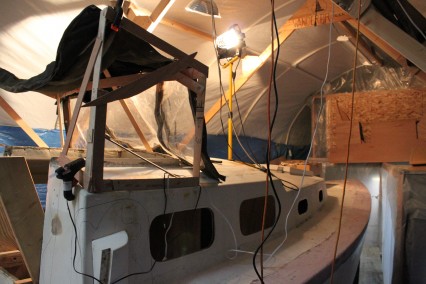
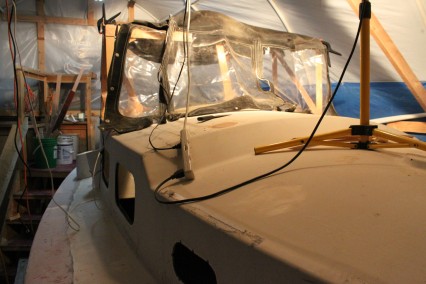
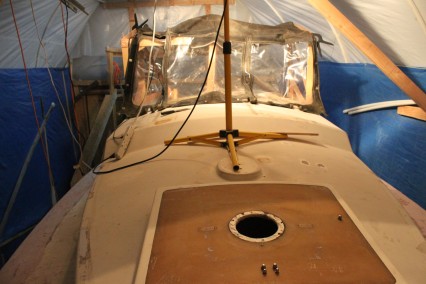
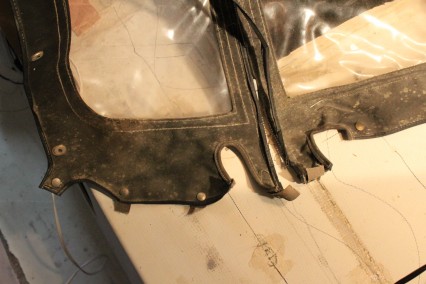
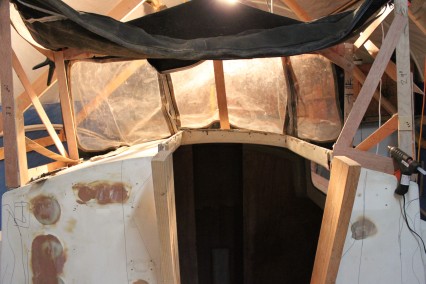
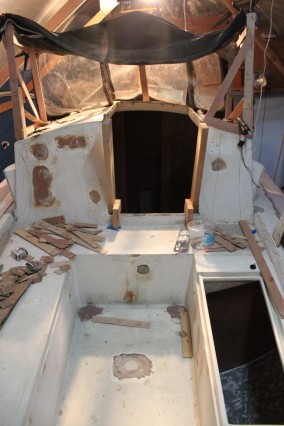
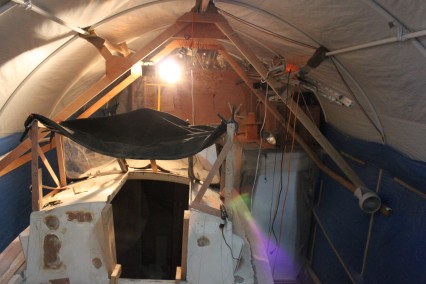
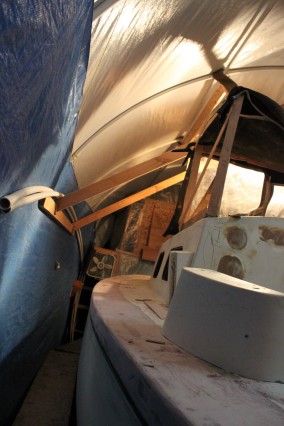
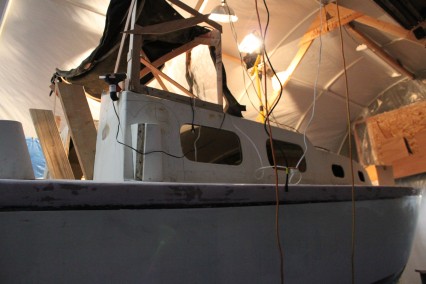
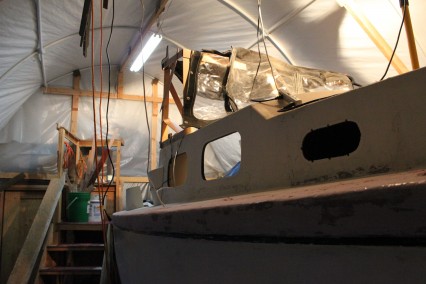
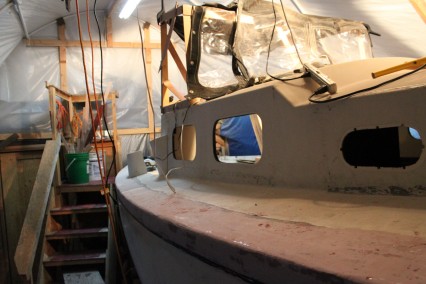
Comment Form